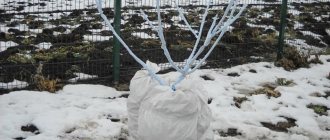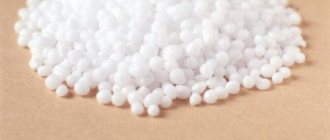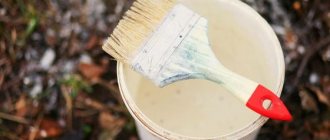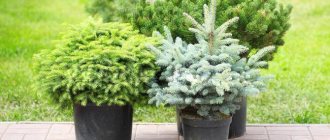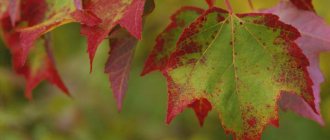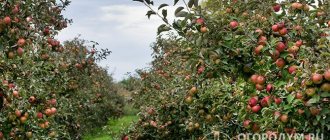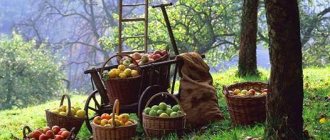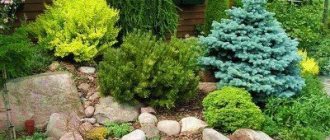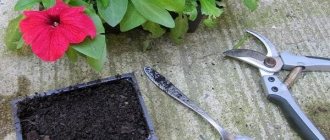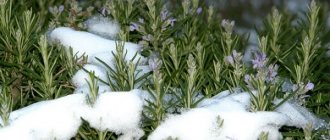How to tie trees to keep hares out for the winter. Please advise how to protect young fruit trees in winter?
Hello! Sorry for raising this topic again, but I just can’t decide on a way to protect fruit seedlings for the winter from rodents, sunburn, etc. The fact is that our site is new, and I don’t even know yet whether we have mice or hares)) although there is a forest across one area from us. The neighbors don't have fruit trees. And those who have apple trees say that they do nothing with them. But they already have mature trees. We planted seedlings (apple and cherry trees) in the fall. Before the frost, I thoroughly covered them with peat, and I thought I’d calm down with that, since all varieties are winter-hardy. But after reading stories here about rodents and February sunburn, I became concerned. Spruce branches, newspaper, wallpaper, garden tape, tights...))) There are no spruce branches. Pantyhose - in SUCH quantities :) - also not. Wallpaper, newspapers and other paper - many reviews indicate the uselessness of such protection. It's too late to whitewash. I bought garden tape for the trunks - but it’s PVC - and somehow I doubted whether the tree would breathe under this tape (((Can’t I just bandage the trunks of the seedlings with a regular bandage? Or will mice gnaw through it too? A plot in the Moscow region, in Pushchino. Snow has already fallen, the temperature is slowly setting below zero, and my seedlings are all uncovered. One three-year-old apple tree, five columns, and cherries. Dear experienced gardeners!) Please advise how I can protect my small trees in winter!
Best answer from Anatolevna (Irina, Bendery):
Several years ago, in the spring I bought young apple and pear seedlings. They took root well, and in the fall they went into winter rooted, and in the spring, when we arrived at the site, we saw that someone had chewed the bark of the seedlings well. A neighbor said that hares were walking around in winter. The pear tree disappeared altogether, but the apple tree was barely saved. Now, my husband and I wrap the trunks of young trees with simple burlap, and press it down with fine mesh on top.
If the hares have ALREADY eaten the trees
If in the spring it turns out that the bark has been gnawed, carefully cover the wounds with garden varnish. If the damage is small, it will quickly heal, but if the gnaws are large, the sap flow will be disrupted and the tree will not be saved.
Two types of hares can visit our gardens: the white hare and the brown hare.
The white hare dresses in a white fur coat in winter. He is a forest dweller and rarely goes beyond his territory.
The hare is gray. Resident of fields and open spaces. Tries to stay close to the villages. There is something to chew on here, especially in winter, when the grass in the fields is covered with snow.
Hares come out for a snack at dusk and feed until dark.
How to protect trees from hares. Protecting the garden from rabbit attacks
Trees and shoots damaged by a hare have their own distinctive characteristics. And it was as if they had cut it right to the root with pruning shears. There may be traces in the form of small holes in the area. Trees may be partially damaged, with bark missing up to 1 meter away.
The optimal protection would be to fence the entire area around the perimeter with a mesh with small holes. It must be raised to a height of 1 meter and buried into the ground at least 30 centimeters. Hares perfectly jump from above and dig tunnels underground. In late spring, you can wrap tree trunks to a height of 1 meter.
Here materials are used at the discretion of the summer resident: roofing felt, parchment paper. I use regular nylon tights.
As one of the available options that I have not seen in any person, I can suggest the use of plastic bottles. They are carefully cut in the middle and the top and bottom are removed. This design protects the tree until spring, when the bottles can be easily removed.
It is convenient to protect tree trunks for summer residents who have access to a river or lake. It is enough to cut the reeds and cover the trunks with them to a height of 1 meter. The installed reeds are secured with rope so that hares do not have access to the trunk. These animals do not eat reeds, so they leave such an area in search of a new tree.
It helps well in protecting the needles. It is enough to break the branches of the needles and place them around the trunk with the needles down. Hares rise up on their paws to eat the bark or shoot. With this arrangement of needles, they will only receive unpleasant and painful sensations. Protection should also include an unpleasant odor that will scare away hares from entering the area itself. I use this trick: I place pieces of hot pepper around the perimeter of the area and near each tree. But there is a peculiarity here: if there has been heavy rain or a thaw has set in, the procedure will have to be repeated, since the pepper will lose its aromatic properties. It is also good to paint the wood with a special solution. It consists of clay and cow dung taken in equal proportions. In order for the tree to be reliably protected, I also add a spoonful of carbolic acid. The specific smell scares hares away from such a tree. Hares are very shy, so it is enough to install noise repellent systems. The best option would be sheets of paper or polypropylene fabric. Any blow of wind will cause such sheets to create noise. Another interesting fact is that some gardeners find dead hares on their property. These animals are so timid that they can get a heart attack even from the rustle of paper.
Another option for the device is cellophane bags. By hanging them on tree branches, you can forget about uninvited guests for a couple of months. Such bags will create rustling noise even in calm weather. One of the options that some gardeners use in our society is feeders for hares. In the summer, they stock up on hay and in winter they put it in installed feeders. But here is a new problem, not only hares are suitable for such feeders, so I do not consider this the optimal and reliable method. The biggest mistake gardeners make is wrapping the tree with straw. This is a surefire way that will definitely attract hares. You should not use mixtures and solutions that contain oils or fats. This will burn the trunk and can completely destroy the tree.
How to do something yourself, with your own hands - home craftsman website
AN EXCELLENT TOOL FOR CRAFTERS AND HANDCRAFTS AND EVERYTHING FOR THE GARDEN, HOME AND Cottage LITERALLY FOR FREE - SEE FOR YOURSELF. THERE ARE REVIEWS.
Of course, hares are very charming, especially in your favorite cartoon.
But his visit to the garden may leave you without apples next year. These shy animals are quite voracious and destroy everything that is poorly “covered”.
Hares are known to be vegetarians, so they are interested in any greens that grow in your garden. Favorite plants are legumes, bulbous plants, young tree bark. In the summer, timid hares are embarrassed to visit the garden, but in the winter they have complete freedom. Moreover, there is no greenery and we have to switch to coarser food - the bark of trees and shrubs. Hares have preferences, these are the bark of apple, plum, apricot, hawthorn, and hazel. And they hardly pay attention to viburnum, currants, honeysuckle, and rose hips.
TOOLS FOR HOME AND GARDEN, HANDCRAFTS, ETC. PRICES VERY LOW
How to save a tree chewed by hares. The trees were gnawed by hares and mice: what to do?
If after winter you find that the bark on garden trees, especially young ones, is damaged, you should immediately take the necessary measures. It is advisable to follow the recommendations described below before the arrival of stable spring warmth, while the plants are still in a state of hibernation.
One of the most important layers of any tree is the cambium. It is a thin layer located between the bark and the main wood. Thanks to it, the tree increases its thickness, forming annual rings that are clearly visible on the cut. He is also responsible for building up the bark. If the cambium is seriously damaged, the tree may die completely.
Apple and apricot trees are the most vulnerable to rodents. Also, these small animals prefer shadberry, but the latter is characterized by high vitality and is restored thanks to new shoots. Among the average ones in terms of damage are cherries and plums, and the most unpopular among rodents is pear.
You can find out which rodents have “ruined” in your garden by the characteristic traces they left behind:
- Mice chew off the thin outer layer in a ring. Most often, the cambium does not receive significant mechanical damage. The easiest way is to wrap the damaged areas tightly with polyethylene film. If the cambium has not yet dried out by this time, most likely everything will be fine.
- Hares and goats cause much more significant damage. To feed, they require a much larger amount of bark, so they damage large areas. If the wound left is narrow enough (no wider than the diameter of the trunk), it can be covered with a mixture of clay and cow dung, taken in equal proportions. Garden varnish is also suitable as a putty. As in the previous example, the top of the damaged area should be tightly tied with plastic film and, additionally, with a piece of roofing material. The latter will provide additional protection against freezing and prevent direct penetration of sunlight.
- The greatest danger comes from the activities of water voles. These animals leave damage on the roots in the underground part of the tree invisible to the eye. It is quite difficult to detect such areas in time. In this case, seedlings are grafted onto the mother tree from 2 or even 4 sides, most of the crown is cut off, and support stakes are installed.
How dangerous are hares for trees?
In winter, these shy animals are most active due to the lack of vegetation. They penetrate the garden and gnaw tree bark, leaving the trees without protection from frost. Rodents give particular preference to apple and serviceberry trees, which have thin, soft bark. Much less often they damage plums, cherries and apricots, because the bark of stone fruit crops is very bitter. Hares almost never touch honeysuckle, rose hips, currants and viburnum.
You can determine that a tree has been damaged by a hare by the following signs:
- shoots of a young fruit crop are cut at the root;
- the bark of young, adult plants is partially or completely torn off in a circle about a meter in height;
- in the garden you can see tunnels, holes, and the remains of hares.
Fruit trees without bark
How to protect young trees in winter. Ways to protect wood from frost
An important step in protection is preparation for winter sleep. It should begin in early autumn or late August. Each fruit tree must be thoroughly watered and fertilized. I use rotted manure or chicken droppings. It is its application that helps to retain heat in winter and prevent the roots from freezing. After applying fertilizer, it is advisable to mulch the root system. But here you need to be careful when choosing the mulching method. Do not use grass or hay, as they will attract hares to the area. The best option would be straw or spruce branches.
As soon as the air temperature outside begins to drop to 0 - 5 degrees Celsius, watering trees, shrubs, and grapes must be completely stopped. If this condition is neglected, the horse system will not have time to adapt to the cold and will freeze. Trees must be pruned in the autumn. In my area, I carry out this procedure 2-3 weeks before the onset of cold weather.
When a plant is pruned, it has the opportunity to accumulate its strength and endure the winter cold more easily. After cutting off excess branches, it is necessary to treat the wounds with oil paint or garden varnish.
Apple trees, especially young ones, tolerate cold very hard. You can protect them by whitewashing the trunk or wrapping it in burlap. I don't use burlap; for young trunks I have old rags and dried reeds.
Roofing felt helps protect tree trunks well. We use this material to protect grapes. We wrap those trunks that no longer fit in the ground with roofing felt, and in almost all cases we manage to protect the plant from frost.
To protect shrubs I use sawdust, pine needles or peat.
Any of these options makes it possible to keep the cold out, thereby protecting the roots from hypothermia. Some summer residents claim that after using sawdust their plant disappeared, the root simply rotted. This option is possible if the laid layer of sawdust is additionally compacted. Not only the access to cold, but also oxygen is blocked to the root system. The plant stops breathing and dies. Roll wallpaper helps protect the plant well. I don’t buy wallpaper specifically for this, but use the old stock that was left after renovating my house and apartment. Their quantity is always sufficient for more than one year. If you live on your summer cottage in winter, then in severe frosts you can artificially raise the air temperature near the tree. Smoke bombs or smoldering firewood are suitable for this. I carry out this procedure only at temperatures of -25, -30. If you do not carry out such procedures, you can lose a lot of plantings.
Rodents are a threat to apple trees in winter
The end of autumn and the beginning of winter represent one of the busiest periods in gardening practice. At this time, the trees begin to prepare for a comfortable entry into the kingdom of low temperatures and heavy rainfall. But, paradoxically, the main stress point is not frost and snow, but regular attacks by hungry rodents.
By gnawing the bark of apple trees, they actually expose the trunk to attack by snow cover. In addition, these animals deprive the tree of its conductor of nutrients and moisture. Peak activity of rodents occurs in February-March. And apple trees are their favorite delicacy, because their bark, unlike stone fruit varieties, is not bitter.
Dangerous animals
The most active pests of fruit trees are the following rodents:
- field mouse - damages the lower part of the tree, making its way to it under the snow;
- water vole - nibbles the root collar of an apple tree;
- hare and wild rabbit - energetically destroy bark more than other pests.
How to protect apple trees from hares. How to protect apple trees from mice and hares in the garden in winter
In winter, mice, hares and other rodents spend most of their time searching for food, and very often our beloved apple trees suffer from this. But it is quite possible to protect a fruit tree from rodents. Let's take a closer look at what control measures need to be taken.
Autumn garden cleaning.
To combat mice and hares, it is necessary to clean the garden area so that there is no food left for rodents. Therefore, we destroy the weeds. We mow the tall thickets along the edges of the garden. We put all the grass clippings into a compost heap or burn them.
Tree trunk circles.
- Digging.
After we have cleared the garden area, be sure to dig up the soil in the tree trunks. Depending on the age of the apple tree, we dig up the trunk circles at a distance of 1.5 to 4 m. The older the apple tree, the larger the trunk circle. Digging up the soil will destroy mouse holes. We also plow the rows to destroy mouse holes.
- Hilling.
After this, be sure to hill the trunks. This simple method will save your apple tree from mice. In spring it is necessary to remove the soil from the trunk.
Barrel protection.
You can protect your apple tree from mice and hares by protecting the trunk. To do this, you can wrap the trunk so that rodents cannot get to the bark. The following can be used as protective material:
- spruce branches, wrapping the trunk with needles down,
- reeds,
- sedge,
- roofing felt
- fine iron mesh.
How to properly tie the trunk of an apple tree.
In order to properly tie the trunk of an apple tree against mice and hares for the winter, you need to slightly rake the earth away from the trunk. If we use a mesh as protection, it is better to dig a groove and bury the mesh. If it is spruce branches or other material, then we also rake away the soil and carefully tie the root part of the apple tree and the trunk itself. Then sprinkle with soil again. That is, it turns out to be hilling. In the spring, we remove all the strapping and remove the hilling.
To protect the apple tree, it is very important not to use grain straw. Because this will serve as food for mice and hares, and they definitely will not leave hell until they eat the apple tree.
Protecting the apple tree in winter.
In winter it is also possible to protect the apple tree. It's quite easy to do. When the snow falls, we walk around the apple tree, compacting the snow. As a result, it will be quite difficult for mice to walk through such snow to the trunk of a fruit tree.
Luring mice
At FORUMHOUSE we use humane methods of rodent control, let the mice live and be happy, just away from our plants. But many people use this method - they scatter poisoned baits in attractive places.
Here is another rather controversial, but proven old method:
Evge Member of FORUMHOUSE
You need to catch one mouse, lightly singe its fur and release it. Her whole family will leave, they can’t stand the smell.
Protecting a Creeping Apple Tree
The creeping or slate apple tree differs from the standard apple tree in its short stature and spreading branches with an almost complete absence of a trunk. During wintering, tree branches are pressed as low as possible to the ground and, depending on the thickness of the branches, are securely secured with poles or metal pipes. Plastic bottles with slotted holes are dug under the tree trunk. They contain poisonous bait. Slate trees overwinter under snow cover and, if necessary, are covered with special nets to protect them from rodents. It is also advisable to use rodent-repellent herbs (mint, elderberry grass or wild rosemary), which are tied to branches.
Treatment methods for trees damaged by rodents
Engraftment of the cortex
The method of grafting healthy bark onto a bare area of the trunk is a rather complex process and does not always give positive results. To patch, take a branch of the same tree and, using a sharp knife, remove the bark from it, adjusting it to the size of the damaged area. Then the place for engraftment is cleared of irregularities with a knife. New bark is applied in accordance with the direction of bark growth on the trunk. The engraftment site must be tightly wrapped with PVC electrical tape, while covering the healthy bark of the trunk along the upper and lower parts by at least 5 cm. After this operation, the tree is provided with regular watering and fertilizing. The composition of fertilizers depends on the soil and the variety of apple tree. This method is most effective when done before sap flow begins.
Vaccinations
A simple method for saving a damaged seedling is bridge grafting. In early spring, before sap begins to flow, strip the damaged edges back to healthy tissue. Cut last year's shoots from the tree, prepare cuttings from them 7 cm longer than the damaged area of the bark, and then sharpen them at an angle 2 cm on each side. Drive the branches under the bark below and above the damaged area with the cut side facing the trunk. The number of cuttings for grafting depends on the thickness of the tree. If the diameter of the trunk is up to 5 cm, 2 cuttings are enough. If the diameter is about 10 cm, you will need 4-5 pieces. Then wrap the bridge with plastic film, tie it with twine and cover it with garden varnish - a paste intended for treating wounds on trees after pruning and when bark breaks. The cuttings will take root and become a kind of donors for the tree, i.e. they will supply food from the roots to the crown. After a few years, the shoots you grafted will become thicker and grow together.
Bridge grafting can save a seedling damaged by rodents
There is another way to save the tree. Plant a wildflower next to the damaged apple tree. Sharpen its top and place it under the bark of the seedling above the damaged area.
Method of cutting a trunk for reverse growth
This method is the most radical, because it involves cutting down the damaged trunk above the lowest bud (1–2 cm above the bud). It is important to cut the tree before the buds begin to bloom, and also not to damage the bud that remains. To prevent the cut stump from starting to sprout in the area of the diseased cut in the spring, it is covered with garden varnish.
Var helps heal damaged areas, protecting against microbes and negative environmental influences.
Garden varnish will help heal damaged areas of the tree and protect against microbes
If the roots of the cut tree are strong and developed enough, then new shoots will appear in the spring. However, this method will not bring a positive effect to a young tree with an undeveloped root system. It is recommended to use a reverse growth cut for trees older than 5 years.
Other recovery methods
A decoction of linden bark heals trees damaged by rodents well. In early spring, chop 200 g of bark into 10-15 cm pieces, pour in 1 liter of cold water and boil for 40 minutes. Cool, strain and thoroughly coat the wounds of the trees with the resulting mass. Wrap the damaged stem on top with thick paper and tie with twine. Do not remove the bandage for several months until the wounds heal.
A clay mash can be used as a healing and healing “balm”. To prepare it, you need to pour 0.5 buckets of clay into a ten-liter bucket and fill it with water 1–2 cm above it. Over the course of several hours, the clay swells and the lumps dissolve. The mass must be stirred several times. If the water is absorbed and disappears, you should add a little more. After 1-2 hours, the clay turns into a thick mass. Carefully coat the damaged trees and wrap them with cotton cloth. When new bark begins to grow in damaged areas, the tissue will spread over it and will not form constrictions in the places where it is located. That is why it is very important to use scraps of cotton fabric for this procedure. If you take silk material, for example, it will not tear when bark grows. The fabric cannot be removed until August, until all wounds have healed.
Video: how to save a tree after damage by hares and rodents
Preserving trees damaged by rodents is problematic. No restoration method will fully guarantee that the cured tree will be able to bear fruit in the future. Therefore, it is extremely important to take care of apple trees in a timely manner, preparing them for winter and protecting them from rodents and hares. Today there are many methods of protection, so every gardener can choose several suitable ones for himself. The more effort you make in November - December, the more likely it is that uninvited guests will not spoil the apple trees planted with love.
- Author: Natalya Art
Since childhood I have loved nature and animals, so writing articles on these topics brings me great pleasure. Rate this article:
- 5
- 4
- 3
- 2
- 1
(2 votes, average: 4.5 out of 5)
Share with your friends!
